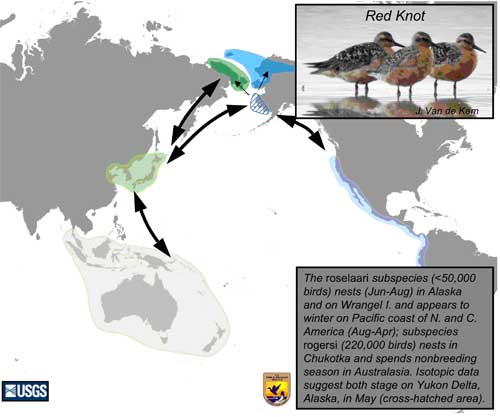Red Knot, Calidris canutus rogersi & roselaari
High-Priority Species ListSampling locations: The primary location is the central YKD (coastal sites from Hooper Bay to Hazen Bay). Secondary locations include known breeding areas (Brooks Range and Wrangel Island) and autumn staging areas (coastal estuaries between Norton Sound and the central Alaska Peninsula). In 2006, birds would be sampled at secondary cites only incidental to other sampling efforts.
Sampling timeframe: During May and August-September on the YKD; during June at known breeding areas (Baird, DeLong, Endicot, and Philip Smith mountains of the Brooks Range); during June on Wrangel Island; during August-September on coastal estuaries of western and southwestern Alaska.
Sample demographics: Adults will be sampled during spring. There are no known areas where adults concentrate in Alaska following nesting. Sparse numbers of juveniles occur fairly regularly in autumn on most estuaries in western Alaska.
Methods of capture: The sample goal of 200 can most easily be achieved through fecal sampling and/or live-trapping of birds at on-shore roost sites in spring, particularly on the central YKD near Tutakoke and Old Chevak. Smaller numbers of samples could be obtained from lethal capture (~20-40 birds).
Other targeted species: At the proposed primary sampling sites it will be possible to sample small to moderate numbers of Bar-tailed Godwits, Dunlin, and Rock Sandpipers.
Contact: Brian McCaffery
U.S. Geological Survey
Contact: Robert Gill
Engelmoer, M., and C. Roselaar. 1998. Geographical variation in waders. Kluwer Academic Publishers, Dordrecht, The Netherlands.
Gill, R. E., Jr., and C. M. Handel. 1981. Shorebirds of the eastern Bering Sea, p. 719-738. In D. W. Hood and J. A. Calder (eds.) The eastern Bering Sea shelf: Oceanography and resources. Vol. 2. Univ. of Washington Press, Seattle.
Gill R. E., Jr., and C. M. Handel. 1990. The importance of subarctic intertidal habitats to shorebirds: a study of the central Yukon-Kuskokwim Delta, Alaska. Condor 92:702-725.
Tomkovich, P. S. 2001. A new subspecies of Red Knot Calidris canutus from the New Siberian Islands. Bull. B.O.C. 12:257-263.

Ranking Score: 12.5 (with fecal sampling score for "Can samples be obtained" would change from 2 to 3 and thus the overall score from 12.5 to 13.5)
Asian H5N1 ranking criteria for Red Knot, Calidris canutus rogersi & roselaari.
Total of partial contact with Asia1 |
Contact with known "hot spot"2 |
Habitat used in Asia3 |
Pop. in Alaska4 |
Can samples be obtained? |
Score |
4.0 |
2.0 |
2.0 |
2.5 |
2.0 |
12.5 |
roselaari pop. nests Wrangel Is & w. Alaska and winters Pacific coast of Americas. rogersi nests Chukotka /New Siberian Is. and winters Australia/New Zealand, passing through c.e. Asia |
On migration rogersi passes through areas wher H5N1 identifiied |
Estuarine |
roselaari <50,000
rogersi 220,000
thought to stop in Alaska in spring but numbers unknown (possibly several 10,000s) |
Could be difficult to obtain target numbers |

